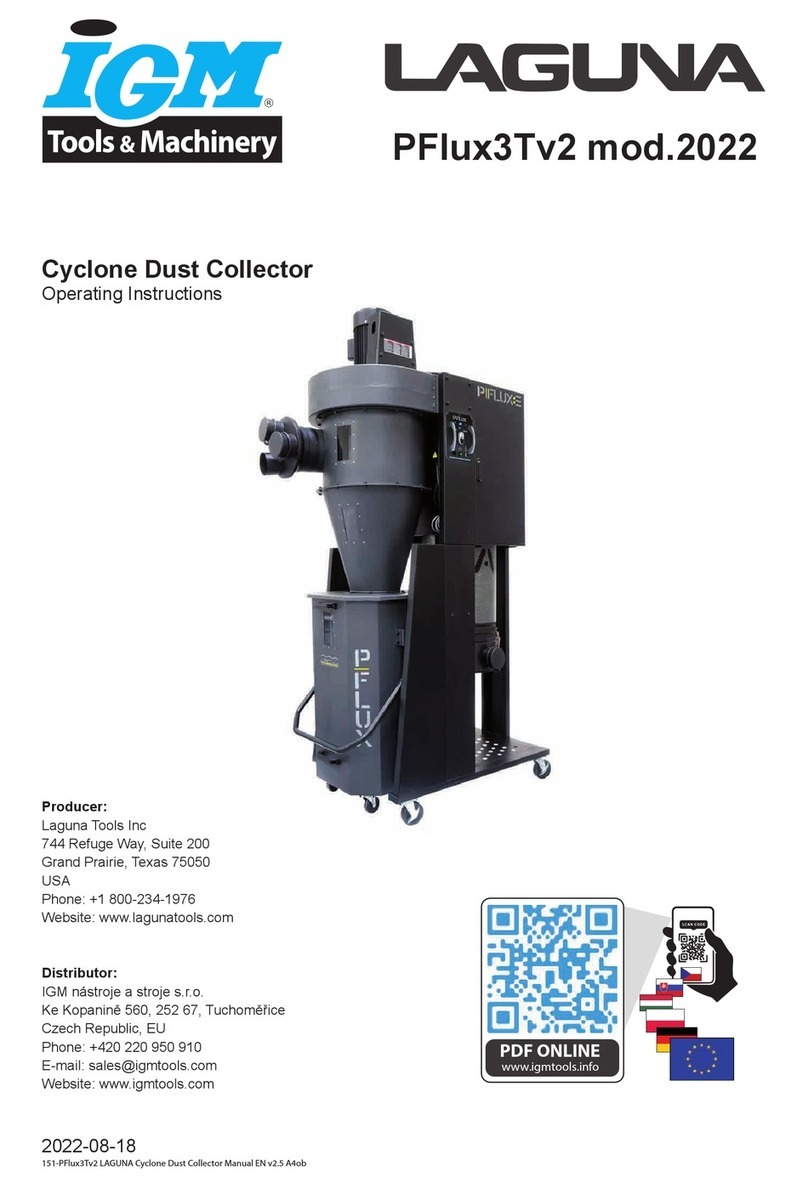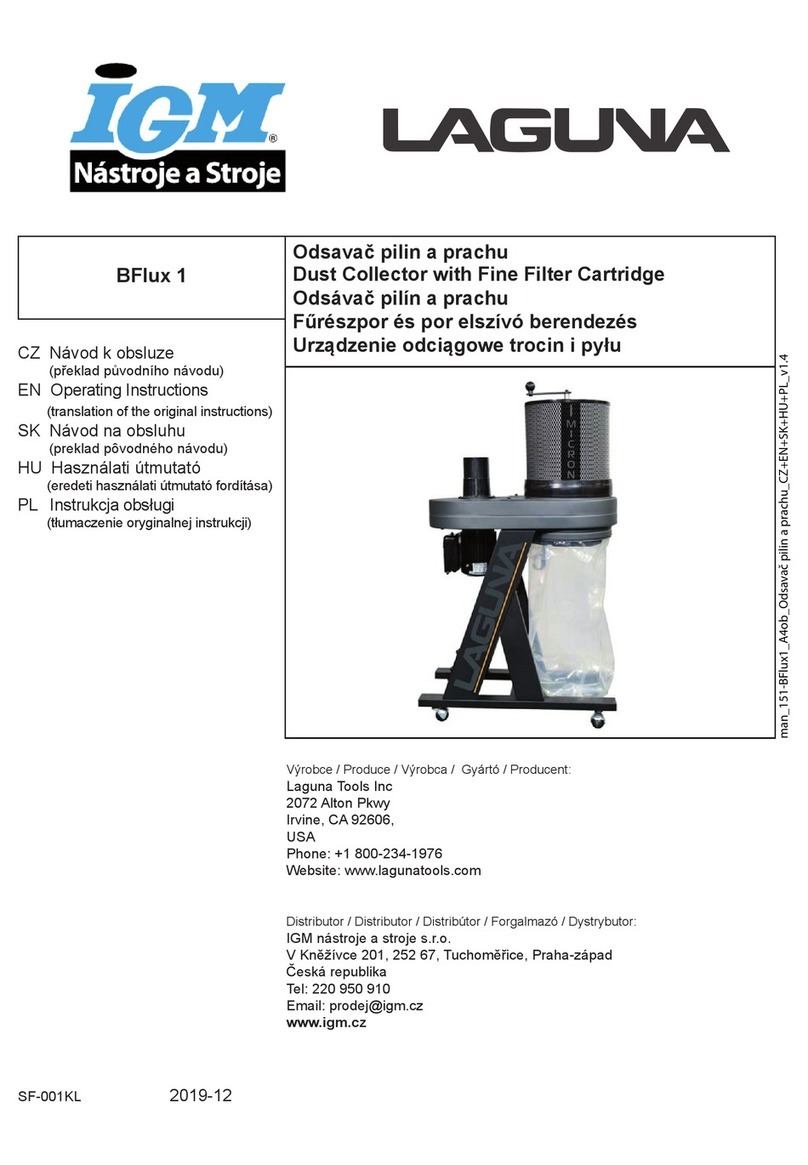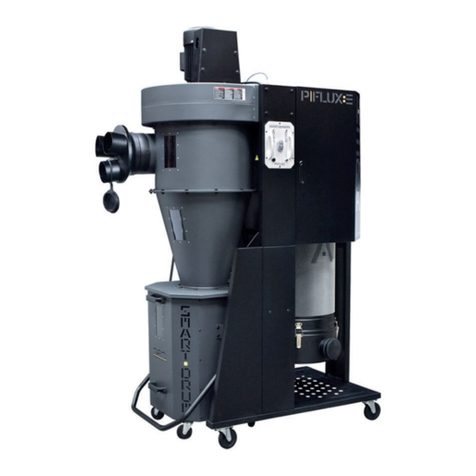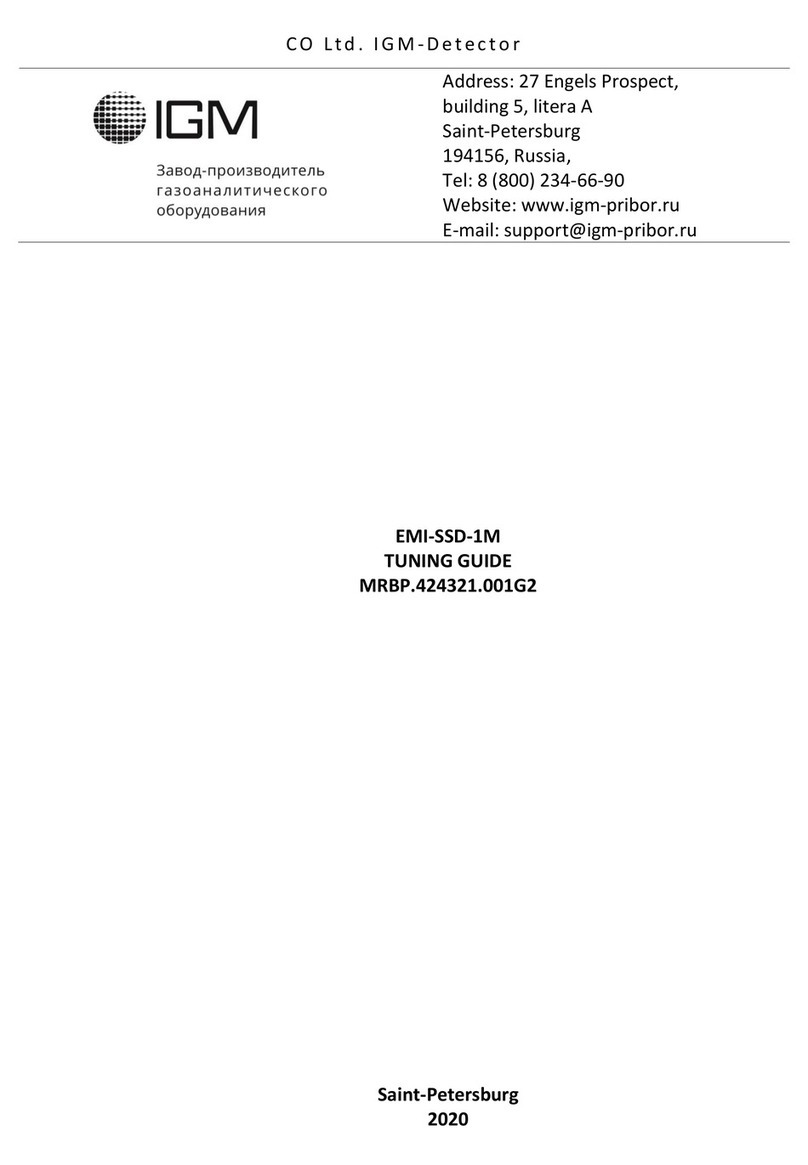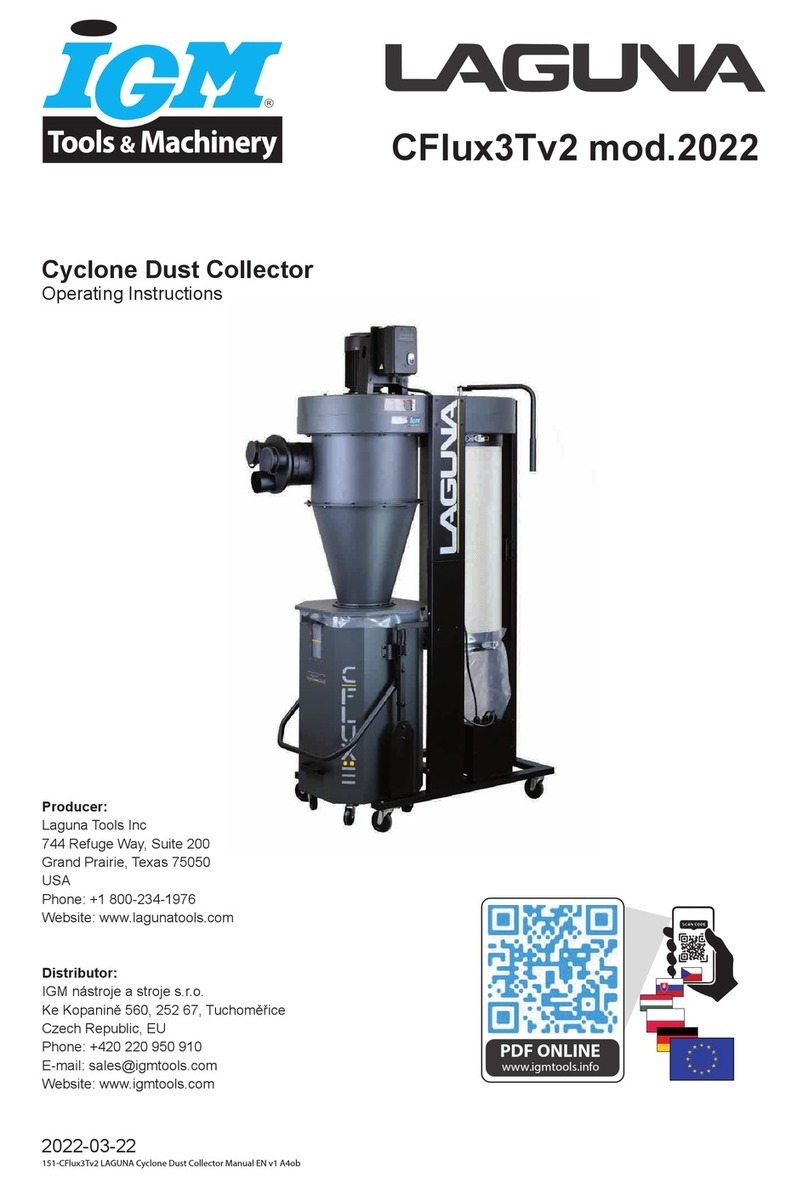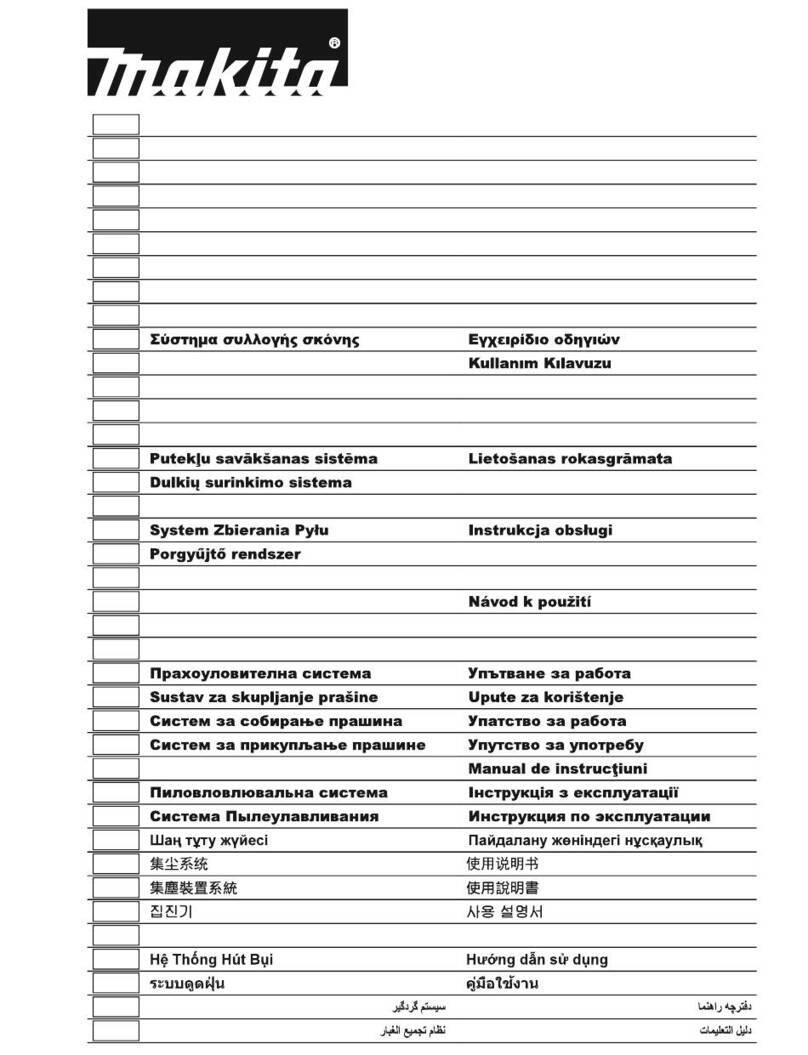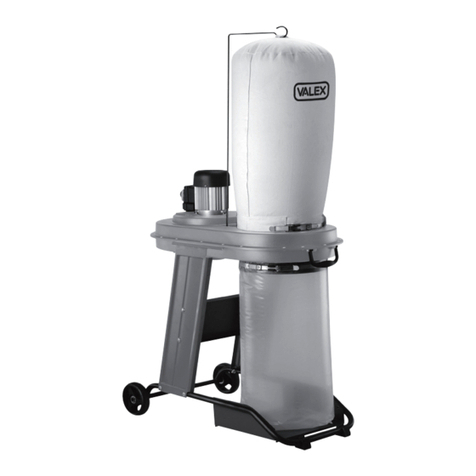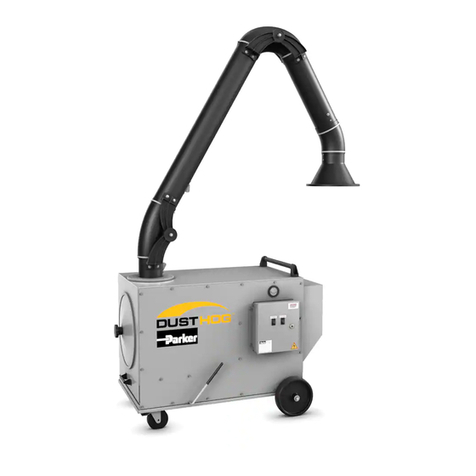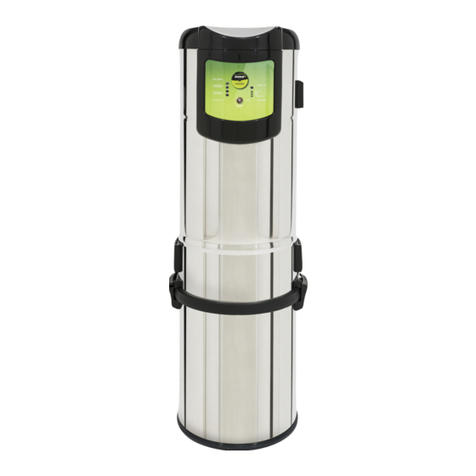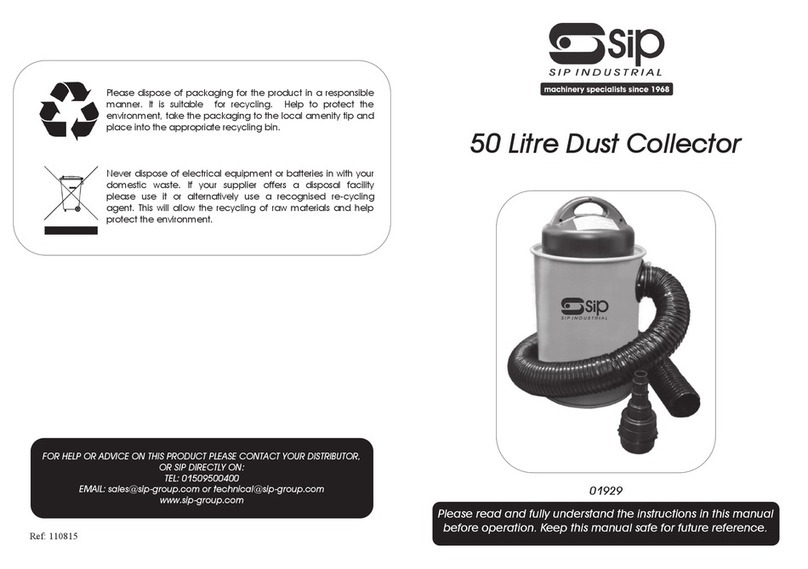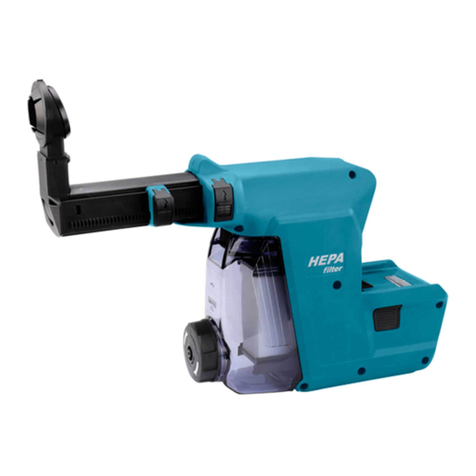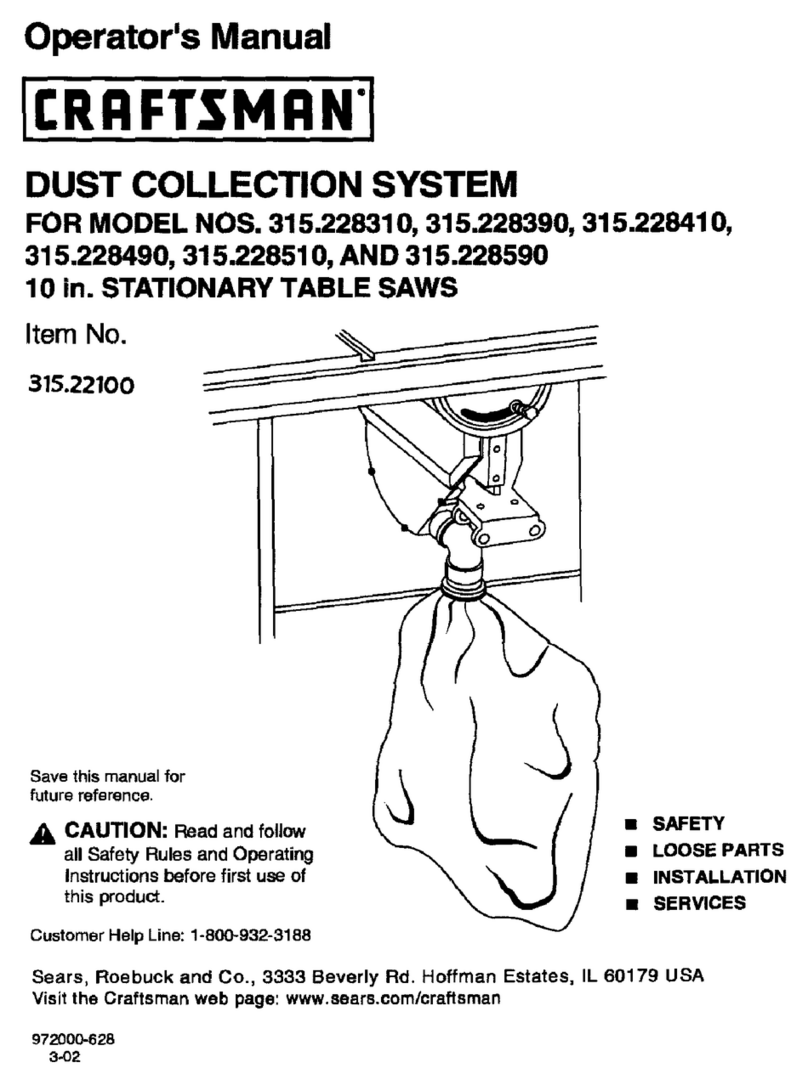IGM Laguna PFlux3Tv2 User manual

Producer:
Laguna Tools Inc
744 Refuge Way, Suite 200
Grand Prairie, Texas 75050
USA
Phone: +1 800-234-1976
Website: www.lagunatools.com
Distributor:
IGM nástroje a stroje s.r.o.
Ke Kopanině 560, 252 67, Tuchoměřice
Czech Republic, EU
Phone: +420 220 950 910
E-mail: [email protected]
Website: www.igmtools.com
2022-04-04
151-PFlux3Tv2 LAGUNA Cyclone Dust Collector Manual EN v2.0 A4ob
www.igmtools.info
PDF ONLINE
PFlux3Tv2 mod.2022
Cyclone Dust Collector
Operating Instructions

-2-www.igmtools.com

-3-www.igmtools.com
Contents
1. Declaration of conformity
1.1 Warranty
2. PFlux3 Specications
3. General Safety Rules and Instructions
3.1 Important Safety Instructions
3.2 General Rules
3.3 Additional Safety Intructions
3.4 Power Supply
3.5 Motor Specications
3.6 Grounding Instructions
4. Parts Description
4.1 Functions
5. Assembly
6.1 Unpacking
6.2 Assembling the Unit
6. Maintenance
7. Troubleshooting
8. Power connection and wiring diagram
9. Parts breakdown / Exploded Views
10. Parts list
1. Declaration of conformity
We declare that this product is in compliance with the directive and the
standard mentioned on the previous page of this manual.
1.1 Warranty
IGM Tools & Machinery strives to always deliver high-quality machinery.
The warranty is governed by the valid terms and conditions of IGM Tools &
Machinery available at www.igmtools.com.
2. Specications
Motor 2200 W
Power 400V / 50Hz / 3 HP
Recommended Breaker Size 16 A, tripping characteristic C (16/3/C)
Airow (traditional method) 3831 m3/hour (2253 CFM)
Airow (realistic method) 2209 m3/hour (1299 CFM)
Max. Static Pressure 285 mm in water
Fan Diameter 390 mm
Inlet Diameter 1x 200 mm nebo 3 x 100 mm
Switch High frequency remote control switch
Noise 76 dB(A) na 3 m
Drum Collection 174 l, octagonal drum
Packing Size (LxWxH) 1300 x 800 x 1300 mm
Weight 175 kg
Shipping Weight 200 kg
Filter
Filtering Area: 9,5 m2
Cartridge Filter diameter 400 mm x height 900 mm
Filtration Size HEPA - 99.2 %, 0.4 Micron
Drum Collection Bag Layat Size 960 x 1200 mm
3. General Safety Rules and Instructions
3.1 Important Safety Instructions
Read and understand all warnings and operating instructions before using
this equipment. Failure to follow all instructions listed below, may result in
electric shock, re, and/or serious personal injury or property damage.
Woodworking can be dangerous if safe and proper operating procedures
are not followed. As with all machinery, there are certain hazards involved
with the operation of the product. Using the machine with respect and
caution will considerably lessen the possibility of personal injury. However,
if normal safety precautions are overlooked or ignored, personal injury
to the operator may result. Safety equipment such as guards, push
sticks, hold-downs, feather boards, goggles, dust masks and hearing
protection can reduce your potential for injury. But even the best guard
won’t make up for poor judgment, carelessness or inattention. Always use
common sense and exercise caution in the workshop. If a procedure feels
dangerous, don’t try it. Figure out an alternative procedure that feels safer.
REMEMBER: Your personal safety is your responsibility.
This machine was designed for certain applications only. We strongly
recommend that this machine not be modied and/or used for any
application other than that for which it was designed. If you have any
questions relative to a particular application, do not use the machine until
you have rst contacted the manufacturer to determine if it can or should
be performed on the product.
If you have any questions relative to its application do not use the product
until you have contacted the manufacturer and we have advised you.
When using an electrical appliance, basic precautions should always be
followed, including the following:
READ ALL INSTRUCTIONS BEFORE USING (THIS APPLIANCE)
To reduce the risk of re, electric shock, or injury:
• Do not leave appliance when plugged in. Unplug from outlet when not in
use and before servicing.
• Do not use outdoors or on wet surfaces.
• Do not allow to be used as a toy. Close attention is necessary when
used by or near children.
• Use only as described in this manual. Use only manufacturer’s
recommended attachments.
• Do not use with damaged cord or plug. If appliance is not working as it
should, has been dropped, damaged, left outdoors, or dropped into water,
return it to a service centre.
• Do not pull or carry by cord, use cord as a handle, close a door on cord,
or pull cord around sharp edges or corners. Do not run appliance over
cord. Keep cord away from heated surfaces.
• Do not unplug by pulling on cord. To unplug, grasp the plug, not the cord.
• Do not handle plug or appliance with wet hands.
• Do not put any object into openings. Do not use with any opening
blocked; keep free of dust, lint, hair, and anything that may reduce air ow.
• Keep hair, loose clothing, ngers, and all parts of body away from
openings and moving parts.
• Turn o all controls before unplugging.
• Use extra care when cleaning on stairs.
EN - English
Operating Instructions (translation of the original instructions)
Dear Woodworker,
Thank you for your purchase and welcome to the Laguna Tools group of discerning woodworkers. We understand that you have a
choice of where to purchase your machines and appreciate the condence you have in the Laguna Tools brand.
Every machine manufactured by Laguna Tools has been carefully designed and well thought through from a woodworker’s perspective.
Through hands-on experience, Laguna Tools is constantly working hard to make innovative, precision products. Products that inspire
you to create works of art, are a joy to run and work on, and encourage your performance.

-4-www.igmtools.com
• Do not use to pick up ammable or combustible liquids, such as
gasoline, or use in areas where they may be present.
• Connect to a properly grounded outlet only. See Grounding Instructions
SAVE THESE INSTRUCTIONS
• Read and understand the warnings posted on the machine and in this
manual. Failure to comply with all of these warnings may cause serious
injury.
• Replace the warning labels if they become obscured or removed.
• This 3HP Portable Cyclone Dust Collector is designed and intended for
use by properly trained and experienced personnel only. If you are not
familiar with the proper and safe operation of this type of dust collector, do
not use until proper training and knowledge have been obtained.
• Do not use this machine for other than its intended use. If used for other
purposes, LAGUNA TOOLS INC., disclaims any real or implied warranty
and holds itself harmless from any injury that may result from that use.
• Always wear approved safety glasses/face shields while using this
machine.
• Before operating this dust collector, remove tie, rings, watches and other
jewelry, and roll sleeves up past the elbows. Remove all loose clothing
and conne long hair. Non-slip footwear or anti-skid oor strips are
recommended. Do not wear gloves.
• Wear ear protectors (plugs or mus) during extended periods of
operation.
• Some dust created by power sanding, sawing, grinding, drilling and other
construction activities contain chemicals known to cause cancer, birth
defects or other reproductive harm. Some examples of these chemicals
are:
• Lead from lead based paint.
• Crystalline silica from bricks, cement and masonry products.
• Arsenic and chromium from chemically treated lumber.
Your risk of exposure varies, depending on how often you do this type
of work. To reduce your exposure to these chemicals, work in a well-
ventilated area and work with approved safety equipment, such as face or
dust masks that are specically designed to lter out microscopic particles.
• Do not operate this machine while tired or under the inuence of drugs,
alcohol or any medication.
• Make certain the switch is in the OFF position before connecting the
machine to the power source.
• Make certain the machine is properly grounded.
• Make all machine adjustments or maintenance with the machine
unplugged from the power source.
• Form a habit of checking to see that all extra equipment such as
adjusting keys, wrenches, scrap, stock, and cleaning rags are removed
away from the machine before turning on.
• Keep safety guards in place at all times when the machine is in use. If
removed for maintenance purposes, use extreme caution and replace the
guards immediately when maintenance is complete.
• Make sure the dust collector is on a at even surface and the wheels
locked in place before use.
• Check damaged parts. Before further use of the machine, a guard or
other part that is damaged should be carefully checked to determine
that it will operate properly and perform its intended function. Check for
alignment of moving parts, binding of moving parts, breakage of parts,
mounting and any other conditions that may aect its operation. A guard or
other part that is damaged should be properly repaired or replaced.
• Provide for adequate space surrounding work area and non-glare,
overhead lighting.
• Keep the oor around the machine clean and free of scrap material, oil
and grease.
• Keep visitors a safe distance from the work area. Keep children away.
• Make your workshop child proof with padlocks, master switches or by
removing starter keys.
• Give your work undivided attention. Looking around, carrying on a
conversation and “horse-play” are careless acts that can result in serious
injury.
• Maintain a balanced stance at all times so that you do not fall or lean
against the dust collector. Do not overreach or use excessive force to
perform any machine operation.
• Use the right tool at the correct speed and feed rate. Do not force a tool
or attachment to do a job for which it was not designed. The right tool will
do the job better and safer.
• Use recommended accessories; improper accessories may be
hazardous.
• Maintain machinery with care. Follow instructions for lubricating and
changing accessories.
• Turn o the machine before cleaning. Use a brush or compressed air to
remove dust or debris — do not use your hands.
• Do not stand on the machine. Serious injury could occur if the machine
tips over.
• Never leave the machine running unattended. Turn the power o and do
not leave the machine until it comes to a complete stop.
3.2 General safety rules
WARNING: FAILURE TO FOLLOW THESE RULES MAY RESULT IN
SERIOUS PERSONAL INJURY.
CHECK DAMAGED PARTS. Before further use of the unit, properly repair
or replace any part that is damaged.
FOR YOUR OWN SAFETY, READ AND UNDERSTAND THE
INSTRUCTION MANUAL BEFORE OPERATING THE MACHINE.
Learn the unit’s application and limitations as well as the specic hazards
peculiar to it.
KEEP WORK AREA CLEAN. Cluttered areas and benches invite
accidents.
DON’T USE IN DANGEROUS ENVIRONMENT. Don’t use this unit in
damp or wet locations, or expose it to rain. Keep work area well-lighted.
KEEP CHILDREN AND VISITORS AWAY. All children and visitors should
be kept a safe distance from work area.
DISCONNECT UNIT before servicing.
CHECK DAMAGED PARTS. Before further use of the unit, properly repair
or replace any part that is damaged.
FAILURE TO FOLLOW THESE RULES MAY RESULT IN SERIOUS
INJURY.
3.3 Additional Safety Instructions
Additional safety for dust collectors
Intended use. This dust collector is only intended for collecting wood dust
and chips from woodworking machines. Do not use this dust collector to
collect metal, dirt, pebbles, drywall, asbestos, lead paint, silica, liquids,
aerosols, or any ammable, combustible, or hazardous materials.
Hazardous dust. Dust created while using machinery may cause cancer,
birth defects, or long-term respiratory damage. Be aware of dust hazards
associated with each work piece material, and always wear a NIOSH-
approved respirator to reduce your risk.
Dust allergies. Dust from certain woods may cause an allergic reaction in
people and animals. Make sure you know what type of wood dust you will
be exposed to in case there is a possibility of an allergic reaction.
Wear respirator. Fine dust that is too small to be caught in the lter will
be blown into the ambient air during operation. Always wear a NIOSH-
approved respirator during operation and for a short time after to reduce
your risk of permanent respiratory damage.
Emptying dust. When emptying dust from the collection container, wear
a respirator and safety glasses. Empty dust away from ignition sources
and into an approved container.

-5-www.igmtools.com
Disconnecting power supply. Turn the switch o, disconnect the
dust collector from the power supply, and allow the impeller to come to
a complete stop before leaving the machine unattended or doing any
service, cleaning, maintenance, or adjustments.
Suspended dust particles and ignition sources. Do not operate the
dust collector in areas were explosion risks are high. Areas of high risk
include, but are not limited to, areas near pilot lights, open ames, or other
ignition sources.
Fire suppression. Only operate the dust collector in locations that contain
a re suppression system or have a re extinguisher nearby.
Impeller hazards. Do not place your hands or tools near the open inlet
during operation for any reason. The powerful suction could easily cause
accidental contact with the impeller, which will cause serious personal
injury or damage to the machine. Always keep small animals and children
away from open dust collection inlets.
Avoiding sparks. Do not allow steel or rocks to strike the impeller—this
may produce sparks. Sparks can smolder in wood dust for a long time
before a re is detected. If you accidentally cut Into wood containing tramp
metal (nails, staples, spikes, etc.), immediately turn o the dust collector,
disconnect it from power, and wait for the impeller to stop—then empty the
collection container into an approved airtight metal container.
Operating location. To reduce respiratory exposure to ne dust, locate
permanently installed dust collectors away from the working area, or in
another room that is equipped with a smoke detector. Do not operate the
dust collector in rainy or wet locations—exposure to water may create a
shock hazard or decrease the life of the machine.
Static electricity. Plastic dust lines generate high amounts of static
electricity as dust chips pass through them. Although rare, sparks caused
by static electricity can cause explosions or re. To reduce this risk, make
sure all dust lines are thoroughly grounded by using a grounding wire.
Regular cleaning. Regularly check/empty the collection bags or drum to
avoid the buildup of ne dust that can increase the risk of re. Make sure
to regularly clean the surrounding area where the machine is operated—
excessive dust buildup on overhead lights, heaters, electrical panels, or
other heat sources will increase the risk of re.
Warning: If precautions are not heeded, it may result in minor injury and/or
possible machine damage.
Warning: If precautions are not heeded, it may result in serious injury or
possibly even death.
SAVE THESE INSTRUCTIONS.
Refer to them often and use them to instruct others.
3.4 Motor Specications
Your machine is wired for 400 volts, 50 HZ alternating current. Before
connecting the machine to the power source, make sure the switch is in
the “OFF” position.
3.5 Grounding Instructions
DANGER: THIS MACHINE MUST BE GROUNDED WHILE IN USE TO
PROTECT THE OPERATOR FROM ELECTRIC SHOCK.
1. This appliance must be connected to a grounded metal, permanent
wiring system; or an equipment-grounding conductor must be run with the
circuit conductors and connected to the equipment-grounding terminal or
lead on the appliance.
The installer, such as a qualied electrician, cut (or bend over) and
insulate the grounding conductor from a eld wiring supply cable.
In the event of certain types of malfunctions or breakdowns, grounding
provides a path of least resistance for electric current—in order to reduce
the risk of electric shock.
Improper connection of the equipment-grounding wire can result in a
risk of electric shock. The wire with green insulation (with or without
yellow stripes) is the equipment-grounding wire. If repair or replacement
of the power cord or plug is necessary, do not connect the equipment-
grounding wire to a live (current carrying) terminal. Check with a qualied
electrician or service personnel if you do not understand these grounding
requirements, or if you are in doubt about whether the tool is properly
grounded. If you ever notice that a cord or plug is damaged or worn,
disconnect it from power, and immediately replace it with a new one.
Electrical Circuit Requirements
You should use a separate electrical circuit for the Laguna CFlux. The
circuit should be protected by a 16A circuit breaker with a tripping
characteristic C (16/3 / C). The power cable of the machine is factory
tted with 400V industrial plug. The machine must be connected to an
appropriate industrial socket or the machine can be connected to a
terminal board and the wiring corresponding to the recommended fuse.
ATTENTION! WIRING MAY BE CARRIED OUT BY A QUALIFIED
ELECTRICIAN ONLY.
Recommended circuit breaker: 16A (16/3/C), tripping characteristic C.
WARNING: MAKE SURE THE SOCKET IS EARTHED. IF YOU ARE
NOT SURE, HAVE THE SOCKET CHECKED BY A QUALIFIED
ELECTRICIAN.
4. Parts Description
4.1 Functional Description
High Frequency Remote Control Receiver and Manual Switch
HEPA Filter detection – will illuminate when lter cleans (automatic
cleaning/override)
Full drum detection – when drum is full, buzzer* will constantly sound o
and light will illuminate.
*When the drum is close to 70%-80% full; intermittent buzzing will occur;
this is a normal state.
ON/OFF Switch – turns cyclone ON or OFF.
On board circuit breaker – Pops out if machine overloads. Press to
reset.
Override – Press for (3) seconds to activate override cleaning while the
cyclone is ON. You can also activate this function by pressing the CLEAN
button on the hand held remote for (3) seconds.
Receiver SET button – Used to program receiver.
ON/OFF Illuminate drum – controls the LED light on the drum lid to
illuminate inside the drum for visuals of the dust level.
Hand held remote controller
*Used to match up a new hand held control with the remote switch
PROGRAMMING THE REMOTE CONTROL
1. Ensure the machine is switch ON before programming the remote
control.
2. Press the black set button on the bottom of the remote switch until you
hear two beeps.
3. Press the Remote set button on your hand held controller
simultaneously with the black button until you hear three beeps to
complete the set up.

-6-www.igmtools.com
MULTIPLE HAND HELD REMOTE SETUP
You can pair up to ve (MAX) hand held remotes; however each hand
held remote needs to be setup individually following the programming
steps above.
If you setup a sixth hand held remote, it will override the rst hand held
remote. If a seventh hand held remote is setup, it will override the second
hand held remote. And so on.
5. Assembly
5.1 Unpacking
Your 3HP Mobile Dust Cyclone comes packed in a single box. Before
attempting to assemble this machine, follow these directions for
unpacking:
1. Carefully cut the banding straps and remove them from the box.
2. Cut along the tape line at the top of the box.
3. Remove all parts from the top of the styrofoam and set aside.
4. Remove the styrofoam packing material from the top of the machine.
5. Carefully take out the machine components from the box and set aside.
6. Using the diagram below, ensure that all parts are present and in good
condition.
Description
A. Motor
B. Remote controller + Manual
C. Dust chute
D. Canister shield (front and back)
E. Top upright supports (3)
F. Canister cover plate
G. Drum insert (4)
H. HEPA Canister lter
I. Filter rotation shaft
J. Filter cleaning arm(2)
K. Crossbar
L. Collection bag for drum(3)
M. Cyclone funnel
N. Cyclone barrel
O. Intake cylinder
P. Octagon drum (front and back panel)
Q. Drum lid
R. Foot peddle bar
S. Filter end cap with 4” suction port
T. Octagon drum base panel
U. Lower upright supports (3)
V. Drum side plate (left and right)
W. Upright support reinforcement plate (3)
X. Foot peddle bar (left and right)
Y. Foot peddle assembly ttings
Y1. Lower triangular support plate (2)
Y2. Foot peddle bar support (2)
Y3. Lower support plate (2)
Z. Intake Reducer (8” by 6”) PFLUX2 only
AB. Intake adapter (8” by 4” x 3 ports) PFLUX3 only
AC. Autoclean plate
AD. Hardware box
Report any missing or damaged parts to your dealer or distributor. Prior to
tool assembly and use, read this manual thoroughly to familiarize yourself
with proper assembly, maintenance and safety procedures.
5.2 General Tool Assembly
This step requires two adults. This 3HP Mobile Dust Cyclone is heavy,
be careful when lifting and handling it! Failure to comply may cause
serious injury and/or damage to the machine and/or property!
Tools Required
10 mm wrench / 12 mm wrench / 14 mm wrench
Phillips screwdriver. 4 mm hex wrench / 5 mm hex wrench
To assemble your dust cyclone, follow these steps:
For your own safety, do not connect the machine to the power source until
the machine is completely assembled. Please also make sure that you
read and understand the entire instruction manual.
ASSEMBLY TIME ESTIMATE 5-6 hours
Step 1: Remove the base which has been bolted to the (3) top upright
supports. Keep the (6) 3/8”x3/4” hex bolts and (6) 3/8” at washers for
assembling the lower supports to the base. Keep the upper assembly
lifted for step 5.
Step 2: Turn base upside-down. Use (16) 5/16” x 3/4” hex bolts and (16)
5/16” at washers. Attach the (2) 4” casters with brakes to the base. The
casters wit brakes should be attached to the side with the opening. The
remaining (2) 4” swivel casters must attach to the other end on the base.
Step 3: Turn the base over with it standing on the (4) 4” casters and
secure the three lower upright support panels using (6) 3/8” x 3/4” hex
bolts and (6) 3/8” x 7/8” at washers..
A – shown with one dot is located on the canister side.
B – shown with two dots is located on the front side
C – shown with three dots is located on the opposite end.
Step 4. With the help of another person carefully lift the upper cyclone
assembly high enough to place on stands that you have completed in
steps 2 and 3. Take note on precisely positioning the upper cyclone
assembly onto the three lower upright supports. Using (6) 5/16” x 3/4” hex
bolts and (6) 5/16” at washers connect and secure the upper and lower
upright supports.

-7-www.igmtools.com
Step 5. Take the intake cylinder, cyclone barrel and cyclone funnel and
install 3 x 6mm foam tape to rims on each locations shown on the left.
- Top rim of the intake cylinder
- Top rim of the cyclone barrel
- Top and lower rim of cyclone funnel
Step 6: Attach the intake cylinder to the dust chute using (4) 5/16”*5/8” hex
spring bolts. Then, attach the cyclone barrel onto the dust chute using (12)
5/16”*3/4” hex bolts and (12) 5/16”*OD18*2t at washers followed by
attaching the cyclone funnel to the barrel using (12) 5/16”*3/4” hex bolts,
(24) 5/16”*OD18*2t at washers and (12) 5/16” hex nuts.
Step 7: Secure the base with (3) lower upright support panels to the
unit using (6) 5/16”*3/4” hex bolts and (6) 5/16”*OD18*2t at washers.
Step 8: Secure the (3) upright support reinforcement plates using (12)
5/16”*3/4” hex bolts and (12) 5/16”*OD18*2t at washers.
Step 9: With the help of another person, lift the unit up carefully to the
right side up with the motor on top and the wheels at the bottom.
Step 10. Secure the side canister lter shield (I) in place using (4)
1/4”*3/4” hex bolts and (4) 1/4”*OD19*2t at washers.
Step 11. Attach the auto clean plate to the dust chute using (12) 3/16”*1/2”
sheet metal thread bolts
Step 12. Take the (2) lter cleaning arms and assemble to the lter
rotation shaft using (4) 1/4”*5/8” hex bolts, (8) 1/4” at washers, and (4)
1/4” hex nuts
Step 13. Insert the lter rotation shaft assembly into the HEPA lter from
the top opening. It will be easier to insert while holding it at a slanted
angle. The rotation shaft has a top and bottom end. The top end has bolt
holes for the next step.

-8-www.igmtools.com
Step 14. Move HEPA lter assembly under the dust chute, and with the
help of another person holding the HEPA lter, secure the top end of the
rotation shaft to the cleaning spindle inside the dust chute using (1) 5/16”
x 1-1/2” hex bolt, (2) 5/16” x OD18 x 2t at washers and (1) 5/16” lock nut.
Step 15. Open the canister lter shield and secure the HEPA canister lter
onto the dust chute by fastening the band clamp on the top part of the
HEPA canister lter. Make sure the band clamp is tightly fastened. It does
not matter which side the clamp faces.
Step 16. Attach the canister lter end cap to the canister lter using the (4)
latches. Cover the 4” hook up with the 4” rubber plug.
Step 17. Secure the lower triangular support plate to the base using (2)
5/16”*3/4” hex bolts and (2) 5/16”*OD18*2t at washers. Follow the same
steps for the opposite side.
Step 18. Locate the two foot pedal bars provided. There is a left side and
right side. To identify the correct side, look for the protruding nut, circled
in red below. It should be facing upwards when you place the bars on the
oor.
Step 19. Ensure that the foot pedal bar is the correct side and slide the
Foot pedal bar into the opening on the lower upright support panel. Make
sure the end of the bar is on the inside of the triangular support plate.
Follow the same steps for the opposite side.
Step 20. Secure the top end of the foot pedal bar to support bracket using
(4) 5/16”*1-3/4” hex bolts, (8)5/16”*OD18*2t at washers and (4) 5/16” hex
nuts. Make sure the foot pedal bar is pushed all the way to the end of the
support bracket (indicated by yellow arrows). Follow the same steps for
the opposite side.
Step 21. Secure the base of the foot pedal bar to the triangular support
plate by holding the lower support plate vertically up against the foot pedal
bar and securing the U channel provided onto the foot pedal bar using
(2)5/16”*1-3/4” hex bolts, (4) 5/16”*OD18*2t at washers and (2) 5/16” hex
nuts from the inside out. Follow the same steps for the opposite side.
Step 22. Attach the cover plate over the foot pedal assembly. Secure
using (6) 1/4”*3/4” hex bolts and (6) 1/4”*OD19*2t at washers. Follow the
same steps for the opposite side.

-9-www.igmtools.com
Step 23. Attach the two ends of the Octagon foot pedal to the nut on the
foot pedal bar.
Step 24. Secure the topping to the nut on the foot peddle bar using (1)
M8*30mm hex bolt. Follow this step on the opposite side.
Step 25. Secure the movable supporting brace on the foot peddle bar with
the octagon foot peddle using (2) 3/8”*21mm hex bolts. Make sure the bolt
head is on the inside of the octagon foot peddle. Adjust the tightness of
this bolt accordingly. If this bolt is too tight, the Octagon foot peddle will not
work smoothly. When too loose it will not pick up the Octagon drum.
Step 26. Secure the movable supporting brace on the foot peddle bar with
the octagon foot peddle using (2) 3/8”*21mm hex bolts. Make sure the bolt
head is on the inside of the octagon foot peddle. Adjust the tightness of
this bolt accordingly. If this bolt is too tight, the Octagon foot peddle will not
work smoothly. When too loose it will not pick up the Octagon drum.
Step 27. Apply foam tape to the cone ange before attaching the drum lid.
Secure the Octagon drum lid to the cyclone funnel using (6) 5/16” x 3/4”
hex bolts, (12) 5/16” x 1” at washers and (6) 5/16” hex nuts. Make sure to
rst attach all the bolts before tightening. NOTE: The lid will turn when the
bolts have not been tightened for alignment. Failure to do will result in the
drum lid not being able to align with the drum.
Step 28. Attach the full drum detection sensor to the opening on the drum
lid located behind the cyclone funnel. When securing the sensor make
sure the end of the sensor is not longer then the drum lid rim. If it extends
longer passed the rim, the detection will not function correctly.
Step 29. Attach the LED light to the drum lid using (6) M4*10mm Philip HD
Bolt, (6) 3/16” at washers and (6) M4 hex nuts.
Step 30. Attach the crossbar to the drum lid and tighten using the two
bolts removed in the previous step. It does not matter which position you
attach the crossbar.
Step 31. Assemble the Octagon drum. Locate the drum base panel, (it
does not matter which side faces inside), and secure the (4) casters using
(16) 5/16” x 3/4” hex bolts, (32) 5/16” x 1” at washers and (16) 5/16” hex
nuts.

-10-www.igmtools.com
Step 32. Attach the handles to the top and bottom end on the front panel
with the window display using (4) at head Philip bolt, (4) 5/16” x 7/8” at
washers and (4) 5/16” hex nuts. Note that the head of the Philip bolt must
be inserted from the handle with the hex nut and washer on the inside of
the drum.
Step 33. Take the Octagon drum front and back panels and assemble
together by securing with (12) M4 x 12mm sheet metal screws.
Step 34. One the left and right side you will nd three bolt holes. Take the
matching side plate and secure to the outside of the panel using (6) 1/4” x
1/2” carriage bolts, (6) 1/4” x 1” at washers and (6) 1/4” hex nuts. Insert
the head of the carriage bolt from the inside of the drum with the washers
and nuts on the outside of the drum.
Step 35. Lay the drum on its side with the handle facing top. With the help
of another person, hold the base panel with wheels up against the base of
the drum. Using (22) M3 x 6mm Truss head Philips at point screws and
M3 cap nuts secure and fasten tightly. Make sure the head of the truss
head Philip screw is on the inside of the drum. The cap nut is secured
from the outside. Otherwise this will cause for air leakage regardless of
silicone being applied.
Step 36. Once completing the assembly, keep the drum laying on its
side to apply silicone (not included) to the inside of the drum, including
the base and the top rim of the drum before the rubber seal has been
attached to seal and prevent air leakages. You will need to use a caulking
gun (not supplied)
Step 37. Attach the rubber gasket to the top inner edges of the Octagon
drum. The wider end of the gasket goes up. Use tin snips to trim any
excess rubber gasket after completing the seal.
Step 38. Insert the plastic debris collection bag inside the Octagon drum.
Open and spread out the plastic bag to the corners and edges.
Step 39. Use (24) Round hd Philip bolts 3/16”*1/2” and (24) Cap nut 3/16”
to assemble the drum insert together. Place the drum insert inside over
the plastic bag in the Octagon drum.
Step 40. Lift the foot peddle bar. Align the Octagon drum window to the
center point of the drum lid and push the drum in. Lower the foot peddle
bar to seal the drum tight for normal machine operation.
Step 41. Make sure when aligning the drum that both the left and right
side lift plates are over the topping on the foot peddle bar assembly before
lifting the foot peddle bar up. When not aligned, the drum will not be fully
sealed and will interfere with the air ow.

-11-www.igmtools.com
Step 42. Using the white plastic pin, insert the sharp point into the top end
of the proximity sensor that is on top of the drum lid. You will nd a small
hole to on top where you can turn clockwise or anti-clockwise.
• Clockwise: Lower dust waste level in drum (Less full drum)
• Anti-clockwise: Higher dust waste level in drum (Fuller drum)
Step 43. A qualied electrician must open the junction box on the auto
clean motor and remove the strain relief at the bottom. Take the second
motor cord leading from the top upright support with the control panel
and insert into the strain relief, connect the wires according to the wiring
diagram. Close and secure the junction box after you have completed the
wiring.
Step 44. Install the intake splitter. For the PFLUX2 install the 8” by 6”
reducer or 8” by 4” x 2 ports to the intake using (3) M4 x 12mm sheet
metal screws. Attach the rubber caps to each 4” port.
For the PFLUX3 install the 8” by 4” x 3 ports to the intake using (3) M4 x
12mm sheet metal screws. Attach the rubber caps to each 4” port.
Step 45. All the assembly steps have been completed.
.
OPERATION
1. Make sure at least one blast gate is open, if connected to a dust
collection system with blast gates.
CAUTION Never operate dust collector with all blast gates closed!
2. Conrm the electrical supply is correct and connected to machine.
3. Make sure no one is working on or doing maintenance to dust collector.
4. To start, press the ON button on either the ON/OFF switch or remote
control.
5. To stop, press the OFF button on either the ON/OFF switch or remote
control.
6. Maintenance procedures
CLEANING THE FILTER
This PFLUX3 is equipped with auto clean every 10 minutes for 10
seconds one direction and another 10 seconds the other direction. The
cleaning will continue for one cycle (10 seconds clockwise, 10 seconds
counterclockwise when you shut the machine o. While the canister is
cleaning the yellow LED light on the control panel will illuminate showing
that it is in the process of cleaning.
There is a HEPA lter replacement indicator, which is the same yellow LED
light as the cleaning one. This is based on a timer system and when 2000
hours of running is reached, the light indication would be ash constantly
in one long, two short intervals meaning the HEPA lter would need to be
replaced.
Pressing the REMOTE button ve times will reset the ashing light.
To ensure proper operation of this Mobile Dust Cyclone, the HEPA canister
lter must have adequate air ow. This means the lter must be regularly
maintained by carefully blowing the lter clean using compressed air and
an air gun to release built-up particulates trapped between the lter pleats.
CAUTION DISCONNECT MACHINE FROM POWER!
For heavy duty users, it is recommended to use compressed air on a
weekly basis to maintain maximum ltration eciency and longer life span
of the lter.
1. Keep your cyclone switched on and operating; open both sides of the
Canister lter shield doors. Connect the Ø4” ex hose from the cyclone to
the Ø4” hook up on the canister end cap.
2. While the cyclone is collecting the dust from inside the canister end cap;
use compressed air and an air gun and blow the outer surface of the
canister.
3. After cleaning the lter with the compressed air gun, follow the steps in
the next section to remove the end cap to empty out any dust left inside.
EMPTYING THE CANISTER END CAP
Periodically check the canister end cap, if it is more than one third full, it is
recommended that you empty it.
NOTE: If the canister end cap gets too full, the dust particulates may be
recirculated back into the canister lter obstructing air ow and exposing
the user to potentially harmful particulates.
1. Release the (4) latches around the canister end cap to remove.
2. Empty and re-attach using the latches.
EMPTYING THE DRUM
Periodically inspect the contents of the drum and empty as needed. To
inspect the contents of the drum:

-12-www.igmtools.com
1. Raise the drum foot peddle bar to lower the drum to the oor.
2. Roll it away from the machine, inspect and empty as needed.
ROUTINE INSPECTION
It is a good idea to routinely inspect any quality woodworking tool in order
to keep it in optimum condition. This includes inspecting all hardware for
tightness, ensuring the lter is clean, and cleaning debris and grime from
any surfaces and moving parts.
HEPA FILTER REPLACMENT
To maintain safe, clean air quality, the HEPA lter should be replaced after
2000 hours of operation (e.g., 8 hours/day x 250 days = 2,000 hours).
Contact your dealer or Laguna Tools for a replacement HEPA lter. If
your model has a “change lter indicator light” it will ash at 2,000 hours.
Replace HEPA lter. To reset ashing light, press the “Remote” button on
the Control Panel 5 times.
CAUTION DISCONNECT MACHINE FROM POWER!
REMOVING THE CANISTER FILTER
1. Release the spring-loaded band clamp at the bottom of the canister
lter and remove the plastic bag.
2. While supporting the canister lter assembly from the bottom, release
the spring-loaded band clamp from the top of the canister lter assembly.
3. Remove the (4) 3/16” x 3/4” sheet metal Philip bolts, (1) 5/16” x 3/4” hex
bolt and (1) 5/16” x 7/8” at washer o the bottom of the canister lter.
4. Remove the canister lter and carefully tilt the top of the canister lter
assembly to clear the paddle branches. Slightly bend the paddle branches
to remove the canister lter.
NOTE: You may have to gently bend the paddles to free the canister lter.
This should not adversely aect the operation of the machine.
5. With the canister lter removed use a compressed air gun to thoroughly
clean between the pleats, both inside and outside.
RE-ASSEMBLING THE CANISTER FILTER AFTER CLEANING
6. With the aid of another person, carefully re-insert the canister lter
repeating step 1,2,3 and 4 in reverse.

-13-www.igmtools.com
7. Troubleshooting guide
Machine does not start or a breaker trips.
Possible Cause
1. Power supply switched OFF or is faulty.
2. Wall fuse/circuit breaker is blown/tripped.
3. Faulty remote control.
4. Remote receiver is faulty.
5. Incorrectly wired motor connection.
6. On-board circuit breaker is tripped.
7. Wiring is open/has high resistance.
8. Faulty power switch.
9. Motor is at fault.
Possible Solution
1. Ensure power supply is ON and has the correct voltage.
2. Ensure adequate circuit size; install inlet restrictor, replace weak breaker.
3. Replace batteries; ensure unobstructed line-of-sight and signal range.
4. Inspect receiver circuit board; replace if faulty.
5. Rewire or call certied service technician or electrician.
6. Allow motor to cool, improve ventilation, press reset button.
7. Check for broken wires or poor connections, repair as necessary.
8. Replace switch.
9. Test/repair/replace.
Excessive vibration or noise during operation.
Possible Cause
1. Loose component.
2. Loose or broken motor mount.
3. Motor fan hitting fan cover.
4. Bad motor bearings.
Possible Solution
1. Inspect and tighten all bolts/nuts.
2. Tighten or replace as needed.
3. Check fan and cover; replace as needed.
4. Rotate shaft manually, check for grinding or loose shaft, replace bearings
if needed.
Loud, repetitive noise, or excessive vibration coming from
cyclone
Possible Cause
1. Machine is on uneven surface.
2. Damaged/Unbalanced impeller.
3. Loose connections.
4. Impeller is loose.
5. Motor fan hitting fan cover.
Possible Solution
1. Stabilize on a at surface.
2. Inspect impeller for dents, bends, loose ns. Replace if needed.
3. Check and re-tighten all fasteners.
4. Replace the motor and impeller.
5. Check fan and cover; replace as needed.
Dust cyclone does not adequately collect dust or chips;
poor performance.
Possible Cause
1. Canister end cap is full.
2. Filter is dirty.
3. Restricted duct line.
4. Suction route is too long or has too many sharp bends.
5. Wet lumber is clogging ducts.
6. Leaks in the duct work or too many open ports.
7. Inadequate velocity in the main suction line.
8. Wrong size ducting/ports used.
Possible Solution
1. Empty canister end cap.
2. Clean lter.
3. Clean inlet splitter.
4. Move machine closer to the point of suction, and rerun ducts to eliminate
sharp bends.
5. Use lumber with less than 20% moisture content.
6. Repair all duct leaks and close any ports not being used.
7. Increase velocity by opening 1 or 2 more blast gates to dierent branch
lines.
8. Re-size and re-install ducts and ttings.
Sawdust being blown into the air from the dust cyclone.
Possible Cause
1. Band clamp or end cap is not secure.
2. Loose or damaged seals.
Possible Solution
1. Re-install ensuring a tight t.
2. Replace seals and gaskets.

-14-www.igmtools.com
8. POWER CONNECTIONS & WIRING DIAGRAMS
CONTROL PANEL
POWER CONNECTIONS

-15-www.igmtools.com
AUTOCLEAN MOTOR
SECONDARY JUNCTION BOX

-16-www.igmtools.com
9. Parts breakdown / Exploded Views
2021. 10. 14
¥ X¹ Ï ³ ¹
¤s´ I¾÷±ñ¤½¥q

-17-www.igmtools.com
10. Parts list
1 PDCPF22201-1 MOTOR 2HP 1
1 PDCPF32201-1 MOTOR 3HP 1
1A PDCPF22201-1A MOTOR GASKET 1
2 PDCPF22201-2 MOTOR SUPPORT BASE 1
2A PDCPF22201-2A HEX LOCK BOLT 5/16” x 5/8” 12
2B PDCPF22201-2B FLAT WASHER 3/8”xOD23x2t” 8
2C PDCPF22201-2C HEX BOLT 3/8”x 1” 4
2D PDCPF22201-2D HEX NUT 3/8” 4
2E PDCPF22201-2E FLAT WASHER 3/8”xOD23x2t 8
2F PDCPF22201-2F HEX BOLT 3/8” x 1-1/4” 4
2H PDCPF22201-2H HEX BOLT 1/4” x 3/4” 4
2I PDCPF22201-2I FLAT WASHER 1/4”xOD19x1t 4
2K PDCPF22201-2K HEX LOCK NUT 3/8" 4
3 PDCPF22201-3 FAN 14.5” (PFLUX2 ONLY) 1
3 PDCPF32201-3 FFAN 15.5” (PFLUX3 ONLY) 1
3A PDCPF22201-3A FLAT WASHER 3/8”xOD45x3t 1
3B PDCPF22201-3B HEX BOLT 3/8”x1” 1
6 PDCPF22201-6 DUST CHUTE 1
6A PDCPF22201-6A CANISTER COVER PLATE 1
6B PDCPF22201-6B SHEET METAL THREAD BOLT 3/16” x 1/2” 12
6C PDCPF22201-6C AUTO CLEAN MOTOR 1
8 PDCPF22201-8 COVER PLATE 1
8A PDCPF22201-8A SHEET METAL THREAD BOLT M4x12mm 4
9 PDCPF22201-9V2
TOP UPRIGHT SUPPORT B V2.2021
1
9A PDCPF22201-9A
HEX BOLT 5/16”x 3/4”
12
9B PDCPF22201-9B FLAT WASHER 5/16”xOD18x2t 12
9C PDCPF22201-9CV2 LOWER UPRIGHT SUPPORT TWO DOT (3B) V2.2021 1
9D PDCPF22201-9D HEX BOLT 1/4”x5/8” 8
9E PDCPF22201-9E FLAT WASHER 1/4”Xod13x1t 16
9F PDCPF22201-9F DOOR STOP PLATE 4
9G PDCPF22201-9G HEX NUT 1/4” 8
10 PDCPF22201-10V2 TOP UPRIGHT SUPPORT A V2.2021 1
10A PDCPF22201-10AV2 LOWER UPRIGHT SUPPORT THREE DOT V2.2021 1
10B PDCPF22201-10B HEX BOLT 5/16” x 3/4” 6
10C PDCPF22201-10C FLAT WASHER 5/16”xOD18x2t 6
10E PDCPF22201-10E HEX BOLT 5/16” x 1-3/4” 4
10F PDCPF22201-10F FLAT WASHER 5/16”xOD18x2t 8
10G PDCPF22201-10G HEX NUT 5/16” 4
10H PDCPF22201-10H TOP UPRIGHT SUPPORT ONE DOT (1A) 1
10I PDCPF22201-10IV2 LOWER UPRIGHT SUPPORT ONE DOT V2.2021 1
10J PDCPF22201-10J UPRIGHT SUPPORT REINFORCEMENT PLATE 3
10K PDCPF22201-10K HEX BOLT 5/16” x 3/4” 12
10L PDCPF22201-10L FLAT WASHER 5/16”xOD18x2t 12
10M PDCPF22201-10M FOOT PEDDLE BAR SUPPORT 2
10N PDCPF22201-10N CARRIAGE BOLT 5/16”x1/2” 4
10O PDCPF22201-10O FLAT WASHER 5/16”xOD18x2t 4
10P PDCPF22201-10P HEX NUT 5/16” 4
11 PDCPF22201-11 FOOT PEDDLE BAR 2
11A PDCPF22201-11A PLUG 25, 25 4
11B PDCPF22201-11B HEX BOLT 3/8” 2
11D PDCPF22201-11D MOVEABLE SUPPORT BRACE 2
11E PDCPF22201-11E HEX LOCK NUT 3/8” 2
11F PDCPF22201-11F SPRING Ø42mm x 242mm L 2
11G PDCPF22201-11G SKID BLOCK 2
11H PDCPF22201-11H OCTAGON DRUM FOOT PEDDLE 1
11J PDCPF22201-11J TOPPING Ø24mm*30mm 2
11K PDCPF22201-11K HEX BOLT M8*30mm 2
11L PDCPF22201-11L HEX BOLT 3/8” 2
11M PDCPF22201-11M HEX LOCK NUT 3/8” 2
11N PDCPF22201-11N HEX BOLT 3/8”x 1-1/2” 2
11O PDCPF22201-11O HEX LOCK NUT 3/8” 2
12 PDCPF22201-12V2 TRIANGULAR SUPPORT PLATE V2.2021 2
12A PDCPF22201-12A HEX BOLT 5/16” x 1-3/4” 4
12B PDCPF22201-12B FLAT WASHER 5/16”xOD18x2t 8
12C PDCPF22201-12C HEX NUT 5/16” 4
13 PDCPF22201-13 LOWER SUPPORT PLATE 2
14 PDCPF22201-14V2 PLASTIC BAG Ø610 x 1200mm 3
15 PDCPF22201-15 BASE 1
15A PDCPF22201-15A HEX BOLT 3/8” x 3/4” 6
15B PDCPF22201-15B FLAT WASHER 3/8” x OD23 x 2t 6
15C PDCPF22201-15C SWIVEL CASTER 4”W/BRAKES 2
15D PDCPF22201-15D FLAT WASHER 5/16”xOD18x2t 16
15E PDCPF22201-15E HEX BOLT 5/16” x 3/4” 16
15F PDCPF22201-15F HEX BOLT 5/16” x 3/4” 4
15G PDCPF22201-15G FLAT WASHER 5/16”xOD18x2t 4
15H PDCPF22201-15H RIVET NUT 1/4” 2
15I PDCPF22201-15I RIVET NUT 3/8” 6
15J PDCPF22201-15J RIVET NUT 5/16” 5
15K PDCPF22201-15K SWIVEL CASTER 2
16 PDCPF22201-16V2 OCTAGON DRUM FRONT PANEL V2.2021 1
16A PDCPF22201-16A FLAT HEAD PHILIP BOLT 5/16”x3/4” 4
16B PDCPF22201-16B HANDLE 2
16C PDCPF22201-16C FLAT WASHER 5/16”xOD23x2t 4
16D PDCPF22201-16D
HEX NUT 5/16”
4
16E PDCPF22201-16E DRUM CASTER 3” 4
16U PDCPF22201-16U HEX BOLT 5/16” x 3/4” 16
16F PDCPF22201-16F FLAT WASHER 5/16”xOD18x2t 32
16G PDCPF22201-16G HEX NUT 5/16” 16
16H PDCPF22201-16HV2 OCTAGON DRUM BACK PANEL V2.2021 1
16K PDCPF22201-16K LEFT SIDE PLATE 1
16L PDCPF22201-16L RIGHT SIDE PLATE 1
16M PDCPF22201-16M CARRIAGE BOLT 1/4” x 1/2” 6
16N PDCPF22201-16N FLAT WASHER 1/4”xOD19x2t 6
16O PDCPF22201-16O HEX NUT 1/4” 6
16P PDCPF22201-16PV2 OCTAGON DRUM BASE PANEL V2.2021 1
16R PDCPF22201-16RV2 WINDOW V2.2021 1
16S PDCPF22201-16S TRUSS HEAD PHILIPS FLAT POINT SCREWS M3 x
6mm 22
16T PDCPF22201-16T CAP NUT M3 22
16Q PDCPF22201-16Q THREAD BOLT M4 x 12mm 12
17 PDCPF22201-17 INTAKE CYLINDER 1
17A PDCPF22201-17A HEX BOLT 5/16” x 5/8” 4
17B PDCPF22201-17B FLAT WASHER 5/16”xOD18x2t 4
18 PDCPF22201-18 CYCLONE BARREL 1
18A PDCPF22201-18A HEX BOLT 5/16” x 3/4” 12
18B PDCPF22201-18B FOAM TAPE 3 x 6mm x 10M 1
18D PDCPF22201-18DV2 CYCLONE FUNNEL V2.2021 1
18E PDCPF22201-18E FLAT WASHER 5/16”xOD18x2t 12
18F PDCPF22201-18F HEX BOLT 5/16” x 3/4” 12
18G PDCPF22201-18G FLAT WASHER 5/16”xOD18x2t 24
18H PDCPF22201-18H HEX NUT 5/16” 12
18I PDCPF22201-18I WINDOW 2
18J PDCPF22201-18J FOAM TAPE 3*15mm*80CM 1
19 PDCPF22201-19V2 OCTAGON DRUM LID V2.2021 1
19A PDCPF22201-19A HEX BOLT 5/16” x 3/4” 8
19B PDCPF22201-19B
FLAT WASHER 5/16”xOD18x2t
16
19C PDCPF22201-19C HEX NUT 5/16” 8
19F PDCPF22201-19F RUBBER GASKET 1650mm 1
20 PDCPF22201-20 BAND CLAMP Ø400mm 1
23 PDCPF22201-23V2 ROTATION SHAFT V2.2021 1
23A PDCPF22201-23A HEX BOLT 1/4” x 5/8” 8
23B PDCPF22201-23B FLAT WASHER 1/4” x OD13 x 1t 16
23C PDCPF22201-23C PADDLE 2
23D PDCPF22201-23D PADDLE BRANCH 4
23E PDCPF22201-23E HEX LOCK NUT 1/4” 8
23F PDCPF22201-23F ROTATION SHAFT CONNECTION 1
23G PDCPF22201-23G HEX BOLT 5/16” x 1-1/2” 1
23H PDCPF22201-23H FLAT WASHER 5/16”xOD18x2t 2
23I PDCPF22201-23I HEX LOCK NUT 5/16” 1
24 PDCPF22201-24 HEPA FILTER Ø400mm x 900mm L 1
24A PDCPF22201-24AV2 HEPA END CAP V2.2021 1
24B PDCPF22201-24B WINDOW 1
24C PDCPF22201-24C FOAM TAPE 5*20mm*1.5M 1
24D PDCPF22201-24D LATCH #98 4
24E PDCPF22201-24E SHEET METAL BOLT 3/16”*3/8” 16
24F PDCPF22201-24F HEX NUT 3/16” 16
25A PDCPF22201-25A ROTATION SHAFT BASE 1
25B PDCPF22201-25B SHEET METAL PHILIP BOLT 3/16” x 3/4” 4
25C PDCPF22201-25C HEX BOLT 5/16” x 3/4” 1
25D PDCPF22201-25D FLAT WASHER 5/16”x OD23 x 2t 1
27 PDCPF22201-27 REDUCER 8” BY 6” 1
27A PDCPF22201-27A SHEET METAL BOLT M4 * 12mm 3
27B PDCPF22201-27B INTAKE SPLITTER 8” BY 4” X 2 PORT 1
27C PDCPF32201-27C INTAKE SPLITTER 8” BY 4” X 3 PORTS 1
28 PDCPF22201-28 RUBBER CAP 4” 1
29 PDCPF22201-29 PLASTIC BASE CONNETOR 1
29A PDCPF22201-29A PH HD BOLT 3/16" x 3/8" 4
29B PDCPF22201-29B HEX NUT 3/16" 4
30 PDCPF22201-30 PLASTIC CAP 4" FOR END CAP 1
31 PDCPF22201-31 CANISTER FILTER SHIELD DOOR-1 1
31A PDCPF22201-31A CANISTER FILTER SHIELD DOOR-2 1
31C PDCPF22201-31C DOOR HANDLE 2
31D PDCPF22201-31D HINGE 4
31E PDCPF22201-31E HEX BOLT M5*10mm 16
31F PDCPF22201-31FV2 COVER PLATE RIGHT V2.2021 1
31G PDCPF22201-31GV2 COVER PLATE LEFT V2.2021 1
31H PDCPF22201-31H HEX BOLT 1/4”*3/4” 6
31I PDCPF22201-31I FLAT WASHER 1/4”*OD19*1t 6
31J PDCPF22201-31J CANISTER FILTER SHIELD 1
31K PDCPF22201-31K HEX BOLT 1/4”*3/4” 4
31L PDCPF22201-31L FLAT WASHER 1/4”*OD19*1t 4
32 PDCPF22201-32V2 DRUM INSERT V2. 2021 4
33 PDCPF22201-33 MOTOR BASE COVER PLATE 1
34 PDCPF22201-34 RIVET 40
34C PDCPF22201-34C RIVET NUT 1/4” 8
34D PDCPF22201-34D RIVET NUT 5/16” 18
35 PDCPF22201-35 SHEET METAL BOLT 3/16”*1/2” 24
35A PDCPF22201-35A NUT 3/16” 24
42 PDCPF22201-42 JUNCTION BOX 1
42A PDCPF22201-42A JUNCTION BOX PLATE 1
42B PDCPF22201-42B PHILIP HD BOLT M4*6mm 4
Ref No Part Number Part Name & Description QTY Ref No Part Number Part Name & Description QTY

42C PDCPF22201-42C HEX BOLT 1/4”x3/4” 2
42D PDCPF22201-42D FLAT WASHER 1/4”XOD19x2t 2
43 PDCPF22201-43V2 CONTROL BOX V2.2021 1
43A PDCPF22201-43AV2 CONTROL PANEL V2.2021 1
43B PDCPF22201-43BV2 CONTROL PANEL SUPPORT PLATE V2.2021 1
43C PDCPF22201-43C ROUND HEAD BOLT M4*10mm 6
43D PDCPF22201-43D PHILIP HD BOLT M4*6mm 4
43E PDCPF22201-43E BUZZER SUPPORT PLATE 1
43F PDCPF22201-43F PHILIP HD BOLT M4*6mm 2
43G PDCPF22201-43G BUZZER/ALARM 1
44 PDCPF22201-44 PHILIP HD BOLT M4*6mm 4
45 PDCPF22201-45 RUBBER HANDLE FOR DRUM INSERT 4
46 PDCPF22201-46 CONTROL PANDLE HANDLE 2
46A PDCPF22201-46A PHILIP HD BOLT M4*6mm 4
47 PDCPF22201-47 CROSSBAR 1
48 PDCPF22201-48 SILICONE 1
49 PDCPF22201-49 LED WINDOW 1
49A PDCPF22201-49A RIVET 3-2 2
50 PDCPF22201-50 LED LIGHT 1
51 PDCPF22201-51 LED LIGHT COVER 1
51A PDCPF22201-51A PHILIP HD BOLT M4*10mm 6
51B PDCPF22201-51B FLAT WASHER 3/16”*OD12*1t 6
51C PDCPF22201-51C HEX NUT M4 6
IGM nástroje a stroje s.r.o., Ke Kopanině 560,
Tuchoměřice, 252 67, Czech Republic, E.U.
+420 220 950 910,www.igm.cz
© 2022 IGM nástroje a stroje s.r.o.
This manual suits for next models
3
Table of contents
Other IGM Dust Collector manuals
Popular Dust Collector manuals by other brands
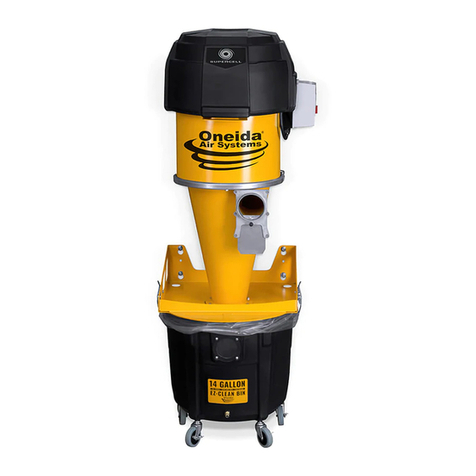
Oneida Air Systems
Oneida Air Systems Supercell XSK000014 owner's manual

South Bend Tools
South Bend Tools SB1007 owner's manual
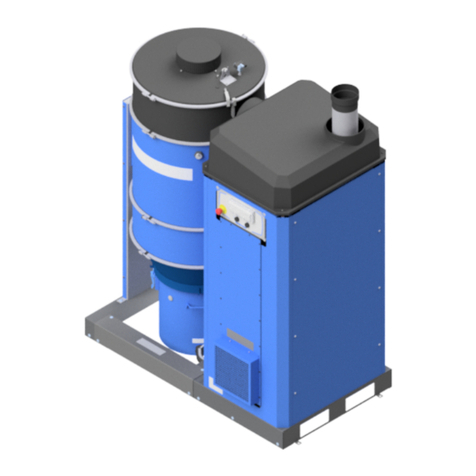
Nederman
Nederman FlexPAK DX Installation and service manual

General International
General International 10-950 Setup & operation manual
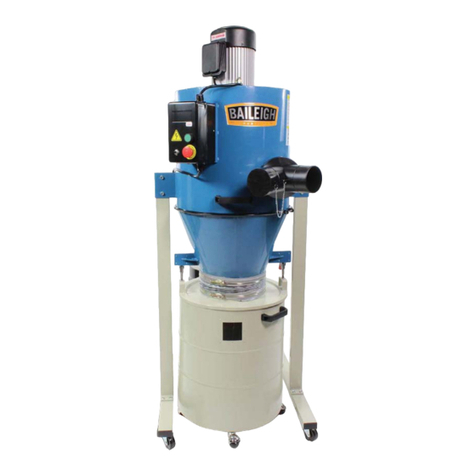
Baileigh Industrial
Baileigh Industrial DC-1450C Operator's manual
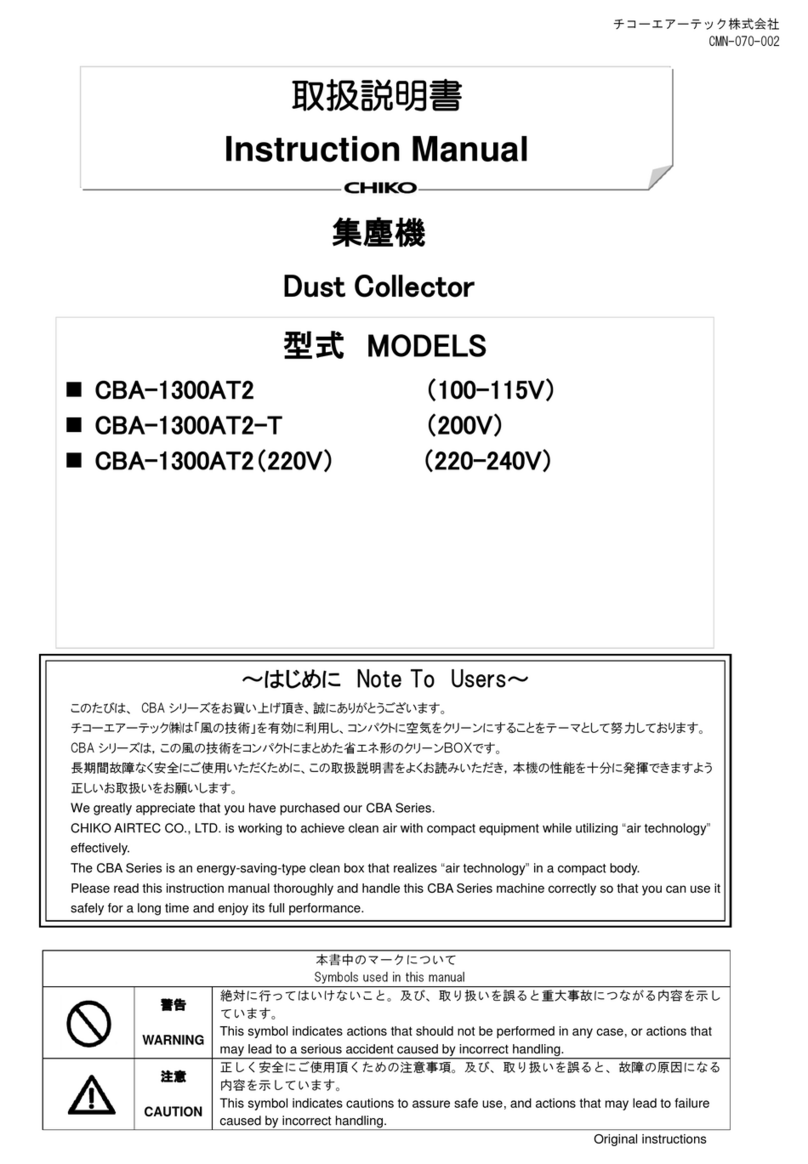
CHIKO AIRTEC
CHIKO AIRTEC CBA-1300AT2 instruction manual
